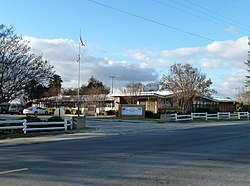United States historic place
| Shafter Research Station | |
| U.S. National Register of Historic Places | |
| U.S. Historic district | |
 | |
  | |
| Nearest city | Shafter, California |
|---|---|
| Coordinates | 35°31′52″N 119°16′41″W / 35.53111°N 119.27806°W / 35.53111; -119.27806 |
| Area | 17.5 acres (7.1 ha) |
| Built | 1922 (1922) |
| NRHP reference No. | 97001211 |
| Added to NRHP | October 17, 1997 |
| Shafter Cotton Research Station | |
|---|---|
 Shafter Cotton Research Station in 1922 Shafter Cotton Research Station in 1922 | |
| Location | 17053 Shafter Avenue, Shafter, Kern County, California |
| Built | 1922 |
| California Historical Landmark | |
| Official name | Shafter Cotton Research Station |
| Designated | March 3, 1997 |
| Reference no. | 1022 |
Shafter Research Station is an agricultural research station near Shafter, Kern County, California, in the San Joaquin Valley.
The station was established in 1922 by the U.S. Department of Agriculture (USDA) as Shafter Cotton Research Station. It was built to provide California with high-quality cotton. Initial research at the station focused on growing long-staple cotton, Egyptian Pima cotton, which was used to make airplane wings at the time. The Hatch Act of 1887 provided for U.S. funding of agricultural science.
By 1925, the researchers had determined that Acala cotton, named after Acala, Texas, was the highest-quality variety of long-staple cotton; they then developed the "one variety" method of cotton production, in which every California cotton producer would grow Acala cotton. As a result of this research, the state of California enacted the California One Variety Cotton Act, which mandated that California cotton producers could grow only Acala cotton. The law spurred the growth of California's fledgling cotton industry, which now forms a major part of the state's agricultural economy. The success of the "one variety" policy caused the station to earn an international reputation for its research, and procedures developed at the station have been used in the Australian and Israeli cotton industries.
The Shafter Cotton Research Station changed from a USDA research station to a private one in June 2012. The San Joaquin Valley Quality Cotton Growers Association now runs the facility. With this change, the former Shafter Cotton Research Station now works other crops, including orchard crops. Today the facility consists of a 20-acre campus, 20 buildings and 60 acres of experimental crops.
The Shafter Research Station was made a California Historical Landmark (#1022) on March 3, 1997, and was added to the National Register of Historic Places on October 17, 1997.
- The California Historical Landmark plaque reads:
- NO. 1022 SHAFTER COTTON RESEARCH STATION - The Shafter Cotton Research Station, established here in 1922 by the U.S. Department of Agriculture, developed the "Acala" varieties which were exceptionally well suited to the San Joaquin Valley. The quality of the Acala cottons and the marketing advantage of the one variety cotton district, created in 1925, resulted in premium cottons with a world-wide demand. Through the continued vision and cooperative efforts of growers and researchers, production of Acala cotton became one of California's largest agricultural enterprises.
See also
- California Historical Landmarks in Kern County, California
- National Register of Historic Places listings in Kern County, California
References
- ^ "National Register Information System". National Register of Historic Places. National Park Service. July 9, 2010.
- "Shafter Cotton Research Station". Office of Historic Preservation, California State Parks. Retrieved October 7, 2012.
- Wilson, Patricia P.; Nina Leigh (November 4, 1996). "National Register of Historic Places Registration Form: Shafter Research Station". National Park Service. Retrieved April 20, 2013.
- Valley Ag Voice, The Shafter Cotton Research Station: 97 Years of Innovation, December 1, 2020, by Mike McCoy
- californiahistoricallandmarks.com # 1022
External links
| U.S. National Register of Historic Places | |
|---|---|
| Topics | |
| Lists by state |
|
| Lists by insular areas | |
| Lists by associated state | |
| Other areas | |
| Related | |
- Agriculture in California
- Research institutes in California
- Buildings and structures in Kern County, California
- Government buildings completed in 1922
- Government buildings on the National Register of Historic Places in California
- National Register of Historic Places in Kern County, California
- Mission Revival architecture in California
- Historic districts on the National Register of Historic Places in California
- Research stations
- Agricultural organizations based in the United States
- United States Department of Agriculture
- Cotton industry in the United States